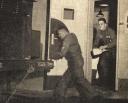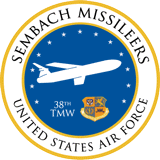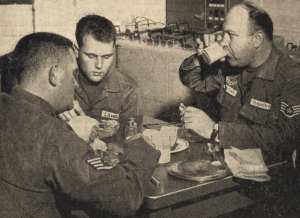Sembach Missileer – March 5, 1965
Four Sembach men spend half of their time in a little house just 90 miles from the Iron Curtain. But it’s no ordinary house. The double fence surrounding it, the armed guards and the sentry dogs patrolling it, and outside, the destruction-shaped silhouettes pointing their noses eastward signify something “verboten”.
Within the walls of this blockhouse (it is one of many), these four missilemen are on combat alert. Outside, the same 10 by 18 foot walls stand four Mace Missiles, poised in constant readiness.
 HEART OF ACTION – From the encircled blockhouse comes the action needed to launch the missiles.Four men must be constantly alert to insure that the Mace is always ready.
HEART OF ACTION – From the encircled blockhouse comes the action needed to launch the missiles.Four men must be constantly alert to insure that the Mace is always ready.
Click on Thumbnail for larger image.
The scene is “A” Flight, one of three flights assigned to the 822nd TM Sq. The 822nd is one of six squadrons within the 38th TMW, headquartered at Sembach.
Life inside the blockhouse is anything but glamorous. The quiet, serious routine of the 12-hour shift offers few diversities.
What is it like to be a tactical missilemen? They’ve been described as “modern knights in dungarees, armed with gyroscopes and transistors, who plunge their skilled hands into the entrails of the gleaming robot to which they are to give life of its own.” I doubt if any member of the 38th could keep a straight face if he heard himself so described. The work is important … glamorous it ain’t.
Missiles and glamour are synonymous only to those who have never witnessed the day-to-day operation. For our four airmen and hundreds more like them, their job is the boredom of ‘repetition until they can do the job swiftly and automatically. Frustration is a part of the job. They never see the Mace in flight here – they hope they never will. But they are ready.
The day begins for combat crew 1-6 at the operations room of the squadron where they assemble for the day or the night shift. After a long security process for entry to the Category 1 area inside the double fence, the crew proceeds to one of three blockhouses, careful not to step inside the yellow line surrounding each complex of four missiles.
According to 1st Lt. Charles Meade, combat crew commander, “Those sentries don’t take too kindly to anyone who doesn’t honor the lines.”
Inside the blockhouse, Lieutenant Meade and his crew replace a crew which is just coming off a 12-hour shift – tired and anxious to get home to the wife and family. Now the serious routine begins for crew 1-6. While Meade is briefed by the relieved crew commander, SSgt. Manley Gilbert a Mace crew chief and a native of Bloomingburg, Ohio, checks the communications network to the combat operations center (from here will come the word to launch if it should ever become necessary).
Meanwhile, two other members of the crew perform a walk around inspection of the four “birds”. They are SSgt. Benjamin C. Eakin, technician 1, from Climax, Ga., and A2C John R. Lambert, technician 2, from Trenton, N. J.
The 12-hour shift inside the blockhouse (only one man can be absent at any one time) might be broken up by the “hot phone”. If it happens to these boys (each site is tested at least once each 48 hours), an eerie warbler horn will penetrate the air over the entire site, setting all other activities in motion while our four men spring into split-second action. All verbal contacts are brisk. No words are wasted. They come from four different directions. In the final stages, when all birds are “go”, there is only silence.
Just what type of weapon is the Mace that is now ready for launch? Its purpose – to destroy enemy targets within a range of 600 nautical miles. Restrictions … virtually none. This bird is impervious to any foul weather such as might ground a manned aircraft.
 START POWER – SSgt. Benjamin Eakin and A2C John Lambert rush out of the blockhouse to start power units for the Mace missile. The two men act as technician 1 and 2 on crew 1-6.
START POWER – SSgt. Benjamin Eakin and A2C John Lambert rush out of the blockhouse to start power units for the Mace missile. The two men act as technician 1 and 2 on crew 1-6.
Click on Thumbnail for larger image.
Sunday is a workday, too.
What about its guidance system … it’s called ATRAN (automatic terrain recognition and navigation), a radar-guided, map-matching system housed in the nose section. It scans its flight path and identifies its route with a microfilm of its target path.
Is it accurate? . . . practically foolproof. We’ve had it for a long time, and it has proven itself repeatedly in tests.
Another thing, it is virtually jam-proof. In short, there is little doubt that the Mace can do its job.
What kind of background qualifies our four airmen to play a part in the control of such a force?
First of all, they are all volunteers who have received at the very least one year of training in missiles and electronics at Lowry and Orlando AFB.
Once the training is completed, the crew reports to a Mace A or Mace B squadron at Sembach, Hahn or Bitburg (two of the 38th squadrons are located at Hahn and one at Bitburg).
After passing a battery of exams, the crew goes about the work of learning still more and demonstrating this knowledge at least once each 30 days before a standardization team. The learning and testing never let up. Many of the blockhouse hours are spent with tech orders and manuals.
Very few hours are wasted in the blockhouse by this crew. Lieutenant Meade is currently enrolled in the University of Southern California masters program in aerospace operations management, conducted twice weekly at Ramstein.
Occasionally, it becomes necessary for the lieutenant to switch shifts with another crew commander so that he can make his classes. The Durham, N. C., native, his wife, Sylvia, and their daughter make their home in the Sembach housing area.
Meade is a graduate of North Carolina State College where he received a degree in Industrial Management. Asked how he feels about his job, he replied, “I feel proud to have been selected to perform such a job. I know of few other jobs for the young officer which carry a greater responsibility.”
No less ambitious is the program embarked on by Sergeant Gilbert. Studying at home and in the blockhouse, the sergeant is putting his quiet hours of alert and off-duty time to use in pursuit of a law degree from the University of LaSalle, Chicago. Gilbert worked in electronics and maintenance for years prior to his arrival at Sembach. He, his wife, Delma, and five children make their home in Sippersfeld, nine miles from the squadron.
Technician 1, Sergeant Eakin, spent his previous years in the military as a radar and navigation equipment mechanic. ECI courses and chess consume the majority of his blockhouse hours. He, too, still resides on the economy, in the village of Erlenbach, with his wife, Bessie, and two daughters.
The lone bachelor in the crew is Airman Lambert. He is also the “green” member, having entered -the military in January, 1963. Lambert readily admits that the hardest part of the job is the long hours of inactivity, especially during the night shift. He, too, has felt the thirst for knowledge and carries courses with the on-base University of Maryland program.
 LONELY MEAL – SSgt. Benjamin Eakin, A2C John Lambert and SSgt. Manley Gilbert eat a lonely meal as they stand vigil in the blockhouse. As members of crew 1-6, they eat at least three meals per tour in their 12-hour “home”.
LONELY MEAL – SSgt. Benjamin Eakin, A2C John Lambert and SSgt. Manley Gilbert eat a lonely meal as they stand vigil in the blockhouse. As members of crew 1-6, they eat at least three meals per tour in their 12-hour “home”.
Click on Thumbnail for larger image.
These four men and hundreds more like them are assigned to eight different locations in West Germany with the 38th Wing. The other squadrons at Hahn and Bitburg combine with Sembach units to add strength to the total NATO military structure.
All of the waiting and frustration are part of the military concept called deterrence. It is the one thing that keeps the free nations of the world free from communist domination.
The job of the launch crew members such as these four is demanding and very unrewarding – but they don’t seek reward. One of their only gripes is that many people are unaware of the job they are doing. Perhaps now you know a little more.
 WAITING FOR AN UNKNOWN TIME – Combat crew members of crew 1-6 occupy themselves with various tasks and pleasures as they await the time when they may have to launch their missiles. Manley Gilbert, A2C John Lambert, SSgt. Benjamin Eakin and 1st Lt. Charles Meade (l to r) are always prepared to answer the call which they hope never comes.
WAITING FOR AN UNKNOWN TIME – Combat crew members of crew 1-6 occupy themselves with various tasks and pleasures as they await the time when they may have to launch their missiles. Manley Gilbert, A2C John Lambert, SSgt. Benjamin Eakin and 1st Lt. Charles Meade (l to r) are always prepared to answer the call which they hope never comes.
Story by Capt. Frederick Judd
Photos by A1C Paul Wilson


